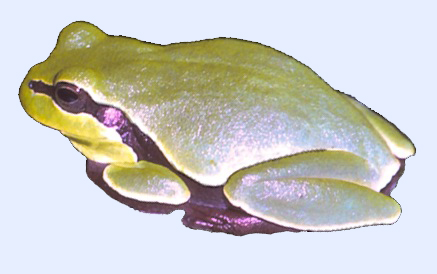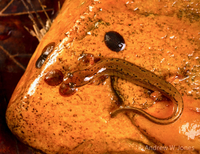Taxonomy
Class: AmphibiaOrder: CaudataFamily: PlethodontidaeSubfamily: Spelerpinae
Taxonomic Comments: Species Comments:
Identification
Description: The Junaluska Salamander is a member of the Eurycea bislineata complex. It somewhat resembles a stocky version of E. wilderae or E. cirrigera , but has a nondescript color pattern, proportionately longer forelimbs, and a proportionately shorter tail (Sever 1983a, Sever et al. 1976). In E. junaluska there are < 2 costal folds between the toe tips of adpressed limbs and the tail is shorter than the body. The short tail is diagnostic, since the adults of other members of the complex typically have a tail that comprises 55-60% of the body length. The dorsum varies from dark brown to greenish yellow or yellowish orange and is overlain with darker brown or blackish flecks or irregular spots that extend to varying degrees onto the upper sides. This species lacks the solid blackish dorsolateral stripes characteristic of E. wilderae , but the sides often have dark blotches or wavy lines that sometimes form a broken dorsolateral line that extends well onto the laterally flattened tail (Niemiller and Reynolds 2011, Petranka 1998). The venter is light colored and lacks mottling. Sexually active males have very short cirri (0.4 mm in length), swollen jaw musculature, enlarged premaxillary teeth, and swollen cloacal and mental glands (Sever 1979). Adults vary from 7.5-10 cm TL and usually have 14 (13-15) costal grooves. E. wilderae . The older larvae also closely resemble those of E. wilderae and in some cases cannot be reliably identified. Small larvae are best separated from E. wilderae using a combination of characters. In general E. junaluska larvae are darker and stockier than E. wilderae of comparable lengths (Ryan 1997, Bruce 1982b). The dorsal ground color is deep olive green to brown, compared to pale yellow or yellowish green in E. wilderae . The margin where the darker pigmentation on the sides meets the lighter coloration that extends from the venter is more or less straight-edged versus being wavy in E. wilderae . Finally, E. junaluska larvae have dense, well defined cheek patches and no iridophores on the venter, while E. wilderae has diffuse cheek patches and abundant iridophores on the venter (Niemiller and Reynolds 2011, Petranka 1998, Ryan 1997). Large larvae have a pattern similar to metamorphosed animals except that larvae have more dorsolateral mottling on the tail (Sever 1983a). Larvae often have a row of 6-7 large melanophores dorsal to the lateral mottling on the trunk. Specimens > 34 mm SVL are in all likelihood E. junaluska since E. wilderae larvae almost never exceed this length in areas of sympatry. Online Photos: Google iNaturalist Observation Methods: The adults can be found beneath cover objects on the forest floor, and beneath rocks and flood debris along the margins of rocky streams during the cooler months of the year. They have been found crossing roads on rainy nights, and can be found beneath rocks in the stream during the breeding season. The larvae most commonly occur beneath large rocks or in leaf litter mats.AmphibiaWeb Account
Distribution in North Carolina
Distribution Comments: This is a relatively rare species that occurs in extreme western North Carolina and adjoining areas in Tennessee. Specimens are known from the Cheoah River drainage in Graham County and in nearby Blount, Monroe, and Sevier counties in Tennessee. Distribution Reference: Beane et al. (2010); Niemiller and Reynolds (2011); Petranka (1998)County Map: Clicking on a county returns the records for the species in that county.
GBIF Global Distribution
Key Habitat Requirements
Habitat: Populations are generally restricted to lower elevation sites (< 730 m) in the mountains that have both breeding streams and intact streamside and forested habitats for the juveniles and adults (Sever 1983a). Adults reside beneath rocks and logs in and about large creeks during the cooler months of the year and in adjoining forest during the summer months. The habitat requirements of this species appears to be generally similar to those of E. wilderae . Biotic Relationships: Natural predators have not been documented, but this species uses perennial streams with fishes and crayfishes and is undoubtedly taken by both. Sever (1983b) surmised that predation from stocked trout may be one explanation for the rarity of this species.
Life History and Autecology
Breeding and Courtship: Sever (1979) found males with spermatozoa in the vas deferentia between October and March which implies a prolonged mating season from autumn through spring. Observations of animals unidirectionally crossing roads suggest that the adults migrate from surrounding forests to the breeding streams in late winter and early spring. Sever (1983b) collected five gravid females crossing a road on 21 March in Monroe County, Tennessee. Courtship behavior has not been described, and it is uncertain if it occurs on land or in water. Reproductive Mode: After mating, the females attach their eggs singly in small clusters to the undersides of rocks in stream channels in a manner that is identical to that of E. wilderae . Ryan (1998) found a single clutch with an attending female on 10 May with 40 embryos. Bruce (1982b) found four clutches with attending females during mid-May. Clutch size varied from 30-49 eggs, and the embryos were at intermediate developmental stages. Three of the four clutches were in compact groups, while the fourth was spread out over a 20 x 5 cm area on the underside of a rock. In all four instances, a female (40-42 mm SVL) was with the eggs. Embryos from three clutches that were transferred to the laboratory hatched in early June. The number of mature ova in 10 females examined by Sever (1983b) varied from 41-68, averaged 51, and was positively correlated with SVL. The largest mature ova were 3.0 mm in diameter. Aquatic Life History: The larvae typically inhabit larger streams and can be found in slow to moderate riffle areas or side pools where they often reside beneath logs and rocks, or within accumulations of leaf litter (Ryan 1998). Chattin et al. (2007) surveyed stream reaches in Tennessee and North Carolina and found larvae associated with low-gradient (<2%) stream reaches that were relatively deep and wide and had abundant silt substrates. The larvae presumably feed on small invertebrates, but dietary studies are lacking. The larvae grow rapidly during the first summer and fall, with growth rates declining thereafter. Terrestrial Life History: Very little is known about many aspects of the natural history of this species. Metamorphs probably disperse from breeding streams during the summer or autumn into the surrounding forest, but the extent to which the terrestrial phase utilizes forest habitats is poorly documented. The adults have been found crossing roads as they migrate to and from the breeding sites, and can be found beneath cover objects along stream margins from the autumn through spring months.
General Ecology
Community Ecology: Eurycea junaluska is remarkably similar to E. wilderae in terms of its breeding biology and larval ecology. These species share breeding sites, but the extent to which they complete for food or oviposition sites beneath rocks is not known. Sever (1983b) surmised that larval competition with E. wilderae may explain why E. junaluska is uncommon at most sites.
Adverse Environmental Impacts
Habitat Fragmentation: Chattin et al. (2007) surmised that this species may have been historically present in the main channels of the Tennessee and Little Tennessee rivers, but was eliminated by a series of six hydroelectric dams and lakes. The resulted in a fragmented population, with the surviving subpopulations restricted to smaller low-gradient streams that are adjacent to the main channels. They further surmised that the current rarity of this species may reflect the fact it is now confined to suboptimal habitats due to habitat loss.
Status in North Carolina
NHP State Rank: S1Global Rank: G2G3Status in North Carolina: T

 »
»


 »
»
